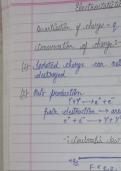1.
What is the magnitude of the force between two point charges of (+3 \\\\mu C) and \\\\(-5 \\\\mu C), separated by a distance of 2 meters in vacuum? Use Coulomb\\\'s Law for your calculation.
Answer: Coulomb\\\'s Law states that the force (F) between two charges (q_1) and (q_2), separated by a distance (r), is given by:
[ F = k \\\\frac{|q_1 q_2|}{r^2} ]
Where:
- (k) is Coulomb\\\'s constant ((8.988 \\\\times 10^9 , \\\\text{N m}^2/\\\\text{C}^2))
- (q_1 = +3 \\\\mu C = 3 \\\\times 10^{-6} , C)
- (q_2 = -5 \\\\mu C = 5 \\\\times 10^{-6} , C)
- (r = 2 , m)
Plugging in the values:
[ F = 8.988 \\\\times 10^9 , \\\\text{N m}^2/\\\\text{C}^2 \\\\times \\\\frac{(3 \\\\times 10^{-6} , C)(5 \\\\times 10^{-6} , C)}{(2 \\\\, m)^2} ]
[ F = 8.988 \\\\times 10^9 \\\\times \\\\frac{15 \\\\times 10^{-12} , C^2}{4 , m^2} ]
[ F = 8.988 \\\\times 10^9 \\\\times 3.75 \\\\times 10^{-12} , \\\\text{N} ]
[ F = 33.705 , \\\\text{N} ]
Thus, the magnitude of the force between the two charges is approximately (33.7 , N).




